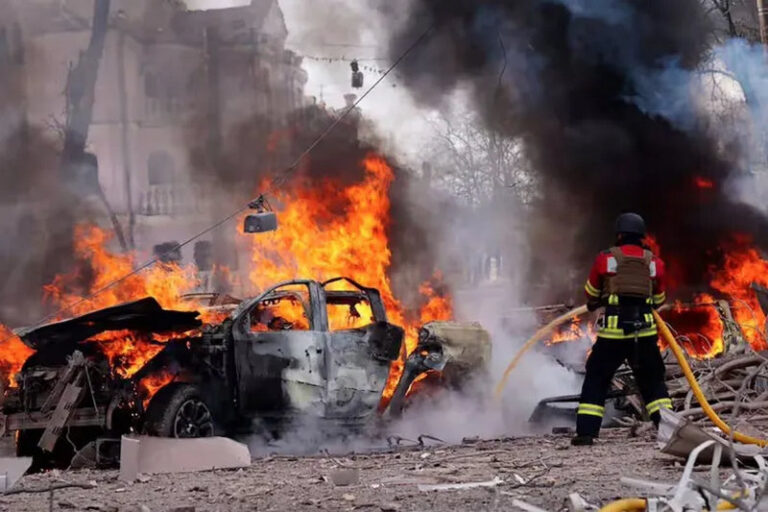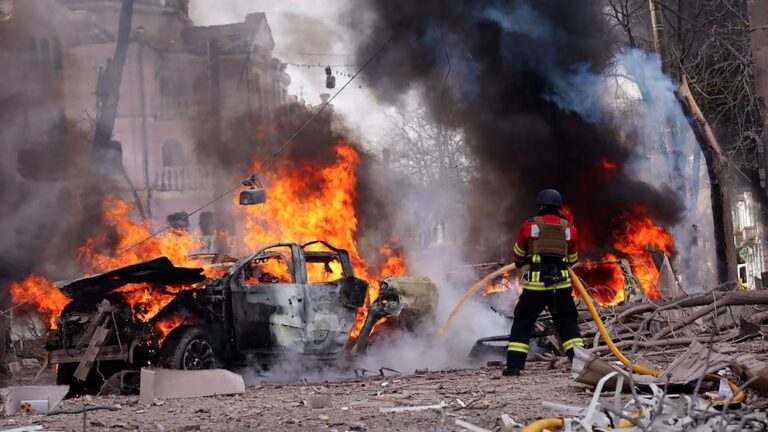1 min read
Ukraine – What Its Military Leadership Says
9 mins read

Volodymyr Zelensky and his generals talk to The Economist (Paywalled)
The writeup is of course full of propaganda but one can still glean some information from it.
The first interview (transcript) was with Volodymyr Zelensky, Ukraine’s president, who is saying nothing new that would be of interest:
“People do not want to compromise on territory,” he says, warning that allowing the conflict to be “frozen” with any Ukrainian land in Russian hands would simply embolden Mr Putin. “And that is why it is very important…to go to our borders from 1991.”
Zelensky wants Crimea back. Good luck achieving that impossibility one might say.
The second interview is with General Valery Zaluzhny, Commander-in-Chief of the Armed Forces of Ukraine. The third interview is with Colonel-General Oleksandr Syrsky, the head of Ukraine’s ground forces.
All three men emphasised that the outcome of the war hinges on the next few months. They are convinced that Russia is readying another big offensive, to begin as soon as January.
The author writes that “Ukraine enjoyed a triumphant autumn.” One wonders how many thousand Ukrainian soldiers have died for that triumph that was in reality a well controlled Russian retreat to shorten its frontlines.
But neither General Zaluzhny nor General Syrsky sounds triumphant. One reason is the escalating air war. Russia has been pounding Ukraine’s power stations and grid with drones and missiles almost every week since October, causing long and frequent blackouts. Though Russia is running short of precision-guided missiles, in recent weeks it is thought to have offered Iran fighter jets and helicopters in exchange for thousands of drones and, perhaps, ballistic missiles.
Yes, we have known since March 2 that Russia is running out of precision-guided missiles. It has since used only 4,500 of those.
“It seems to me we are on the edge,” warns General Zaluzhny. More big attacks could completely disable the grid. “That is when soldiers’ wives and children start freezing,” he says. “What kind of mood will the fighters be in? Without water, light and heat, can we talk about preparing reserves to keep fighting?”
When it is cold and dark morale indeed becomes a problem. It is not the only one.
A second challenge is the fighting currently under way in Donbas, most notably around the town of Bakhmut. General Syrsky, who arrives at the interview in eastern Ukraine in fatigues, his face puffy from sleep deprivation, says that Russia’s tactics there have changed under the command of Sergei Surovikin, who took charge in October. The Wagner group, a mercenary outfit that is better equipped than Russia’s regular army, fights in the first echelon. Troops from the Russian republic of Chechnya and other regulars are in the rear. But whereas these forces once fought separately, today they co-operate in detachments of 900 soldiers or more, moving largely on foot.
Bakhmut is not an especially strategic location. Although it lies on the road to Slovyansk and Kramatorsk, two biggish cities (see map), Ukraine has several more defensive lines to fall back on in that direction. What is more, Russia lacks the manpower to exploit a breakthrough. The point of its relentless onslaught on Bakhmut, the generals believe, is to pin down or “fix” Ukrainian units so that they cannot be used to bolster offensives in Luhansk province to the north. “Now the enemy is trying to seize the initiative from us,” says General Syrsky. “He is trying to force us to go completely on the defensive.”
If Bakhmut is not a strategic location why is the Ukrainian army sending more and more troops into it? Russia is using Bakhmut not only to “fix” Ukrainian units. It is using it to eliminate them with up to 500 Ukrainian soldiers killed or wounded per day. The real fixing operation is happening elsewhere.
Ukraine also faces a renewed threat from Belarus, which began big military exercises in the summer and more recently updated its draft register. On December 3rd Sergei Shoigu, Russia’s defence minister, visited Minsk, the Belarusian capital, to discuss military co-operation. Western officials say that Belarus has probably given too much material support to Russian units to enter the fray itself, but the aim of this activity is probably to fix Ukrainian forces in the north, in case Kyiv is attacked again, and so prevent them from being used in any new offensive.
General Zaluzhny has a quite realistic view on what is coming:
“Russian mobilisation has worked,” says General Zaluzhny. “A tsar tells them to go to war, and they go to war.” General Syrsky agrees: “The enemy shouldn’t be discounted. They are not weak…and they have very great potential in terms of manpower.” He gives the example of how Russian recruits, equipped only with small arms, successfully slowed down Ukrainian attacks in Kreminna and Svatove in Luhansk province—though the autumn mud helped. Mobilisation has also allowed Russia to rotate its forces on and off the front lines more frequently, he says, allowing them to rest and recuperate. “In this regard, they have an advantage.”
But the main reason Russia has dragooned so many young men, the generals believe, is to go back on the offensive for the first time since its bid to overrun Donbas fizzled out in the summer. “Just as in [the second world war]…somewhere beyond the Urals they are preparing new resources,” says General Zaluzhny, referring to the Soviet decision to move the defence industry east, beyond the range of Nazi bombers. “They are 100% being prepared.” A major Russian attack could come “in February, at best in March and at worst at the end of January”, he says. And it could come anywhere, he warns: in Donbas, where Mr Putin is eager to capture the remainder of Donetsk province; in the south, towards the city of Dnipro; even towards Kyiv itself. In fact a fresh assault on the capital is inevitable, he reckons: “I have no doubt they will have another go at Kyiv.”
The general is building and holding back reserves which is problematic for the front lines:
The temptation is to send in reserves. A wiser strategy is to hold them back.
…
“May the soldiers in the trenches forgive me,” says General Zaluzhny. “It’s more important to focus on the accumulation of resources right now for the more protracted and heavier battles that may begin next year.”Ukraine has enough men under arms—more than 700,000 in uniform, in one form or another, of whom more than 200,000 are trained for combat. But materiel is in short supply. Ammunition is crucial, says General Syrsky. “Artillery plays a decisive role in this war,” he notes. “Therefore, everything really depends on the amount of supplies, and this determines the success of the battle in many cases.” General Zaluzhny, who is raising a new army corps, reels off a wishlist. “I know that I can beat this enemy,” he says. “But I need resources. I need 300 tanks, 600-700 IFVs [infantry fighting vehicles], 500 Howitzers.” The incremental arsenal he is seeking is bigger than the total armoured forces of most European armies.
Does Zaluzhny really believe that he could get that force? I don’t think so.
The Economist points out that donors of weapons have run out of pretty much everything:
On December 6th America’s Congress agreed in principle to let the Pentagon buy 864,000 rounds of 155mm artillery shells, more than 12,000 GPS-guided Excalibur shells and 106,000 GPS-guided GMLRS rockets for HIMARS—theoretically enough to sustain Ukraine’s most intense rate of fire for five months non-stop. But this will be produced over a number of years, not in time for a spring offensive.
Russia has similar problems. It will run out of “fully serviceable” munitions early next year, says an American official, forcing it to use badly maintained stocks and suppliers like North Korea. Its shell shortages are “critical”, said Admiral Tony Radakin, Britain’s defence chief, on September 14th.
The last part is of course as valid as the claim that Russia is ‘running out of missiles’.
But even while lacking armored forces and ammunition Ukraine still dreams of big attacks:
“With this kind of resource I can’t conduct new big operations, even though we are working on one right now,” says General Zaluzhny.
The writer discusses various options where Ukraine could attack but finds that it does not really have a good one. The big victory over Russia will not be coming:
In private, however, Ukrainian and Western officials admit there may be other outcomes. “We can and should take a lot more territory,” General Zaluzhny insists. But he obliquely acknowledges the possibility that Russian advances might prove stronger than expected, or Ukrainian ones weaker, by saying, “It is not yet time to appeal to Ukrainian soldiers in the way that Mannerheim appealed to Finnish soldiers.” He is referring to a speech which Finland’s top general delivered to troops in 1940 after a harsh peace deal which ceded land to the Soviet Union.
So how many soldiers will still have to die before Zaluzhny is willing to give his Mannerheim speech (vid)? He does not say.
He will probably have to hold his speech sooner than he thinks because the Ukrainian economy has broken down. GDP decreased by 33% this year and, as attacks on the electrical net continue, it will shrink by another 5 or 10% next year. Inflation is above 20%, unemployment above 30%. The big metal and mining industries had to shut down as they depend on uninterrupted electricity supplies. Meanwhile donors are unwilling to hand to Ukraine the budget it claims to need.
It seems possible that the pending bankruptcy of Ukraine may indeed end the war earlier than any military action.




